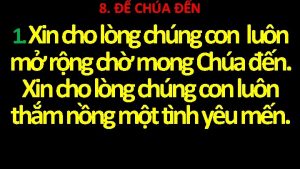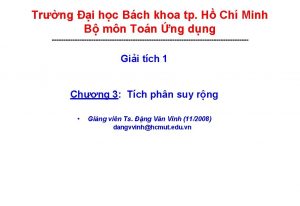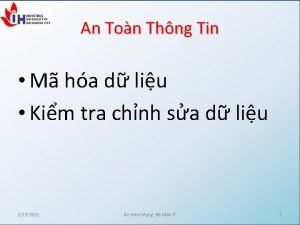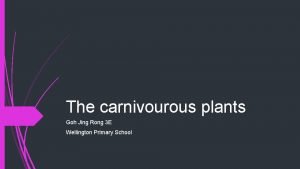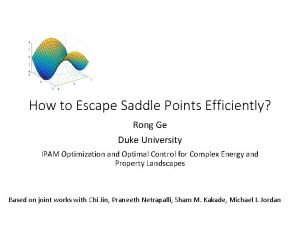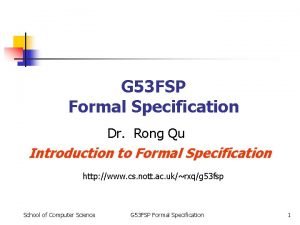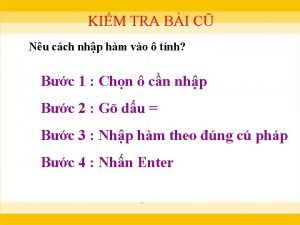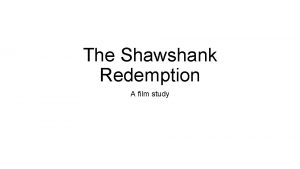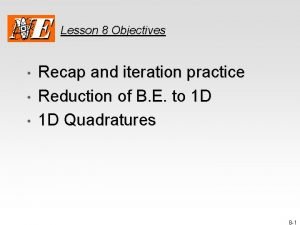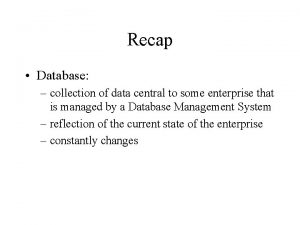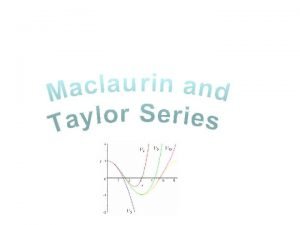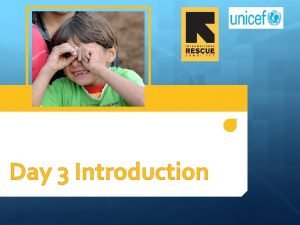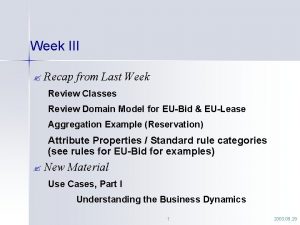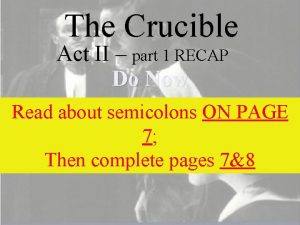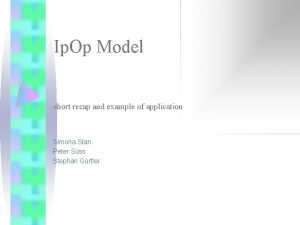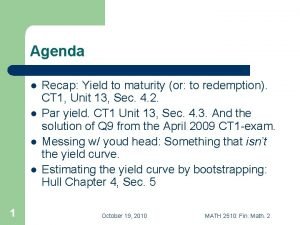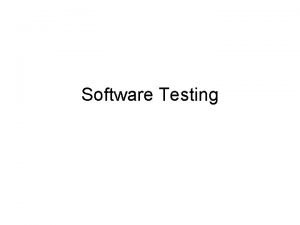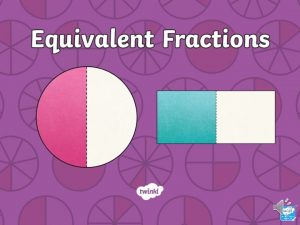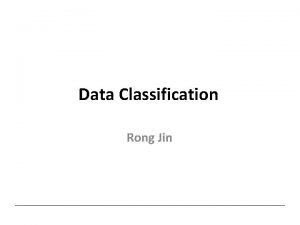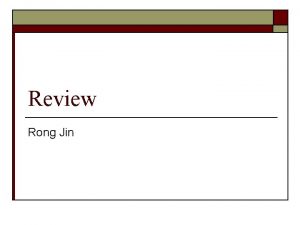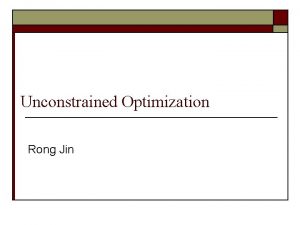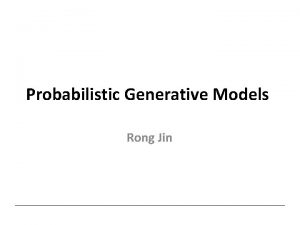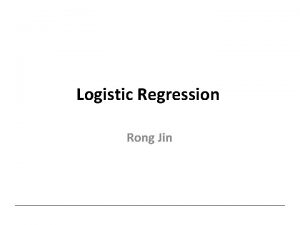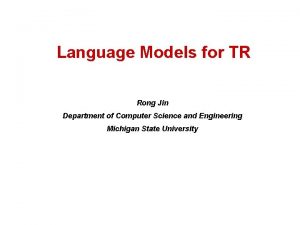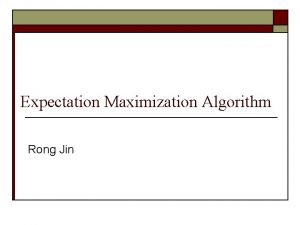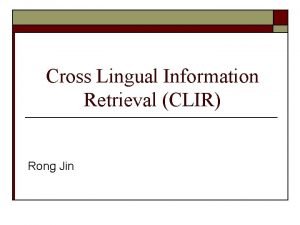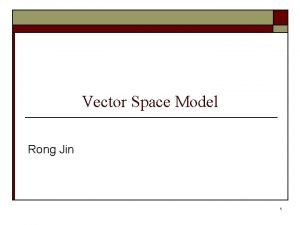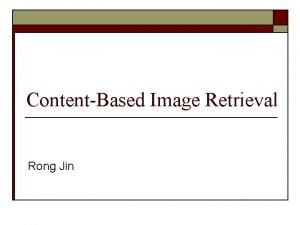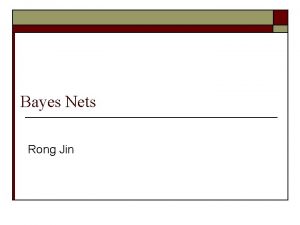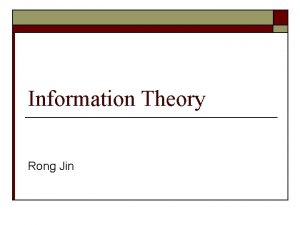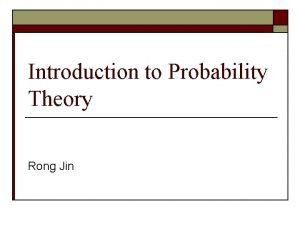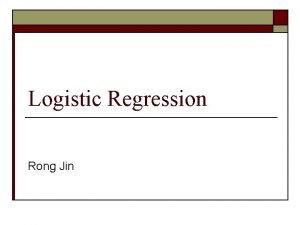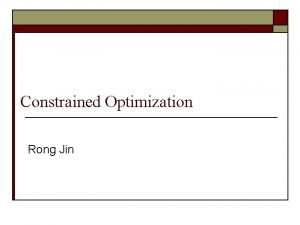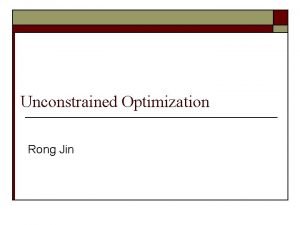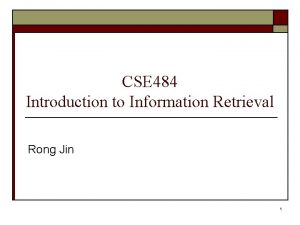Linear Models II Rong Jin Recap o Classification





























- Slides: 29

Linear Models (II) Rong Jin

Recap o Classification problems n n n o Inputs x output y y is from a discrete set Example: height 1. 8 m male/female? Statistical learning approaches for classification problems Training Examples (1. 8 m, m) (1. 87, m) (1. 65, f) (1. 66, m) (1. 58, f) (1. 63, f) Learning a Statistical Model Prediction p(h|male), p(male) p(male|1. 8) p(f|male), p(female) p(female|1. 8) p(y|x; )

Recap o Generative Model n p(y|x): determine the class y for object x o o o p(y): how frequent class y appears p(x|y): the input pattern for class y Example: n n 1. 8 m male? female? p(male|1. 8 m) = p(male)p(1. 8 m|male)/p(1. 8 m) p(female|1. 8 m) = p(female)p(1. 8 m|female)/p(1. 8 m) = p(1. 8 m|male)p(male)+p(1. 8 m|female)p(female)

Recap o Learning p(x|y) and p(y) n n o p(y) = #example(y)/#examples Maximum likelihood estimation for p(x|y) Example n Training examples: o n n p(male) = Nmale/N p(female) = Nfemale/N Assume that the height distributions for male and female are Gaussian o n (1. 8 m, m) (1. 87, m) (1. 65, f) (1. 66, m) (1. 58, f) (1. 63, f) ( male, male), ( female, female) MLE estimation

Recap

Recap

Recap o Naïve Bayes n n Input x is a vector: x={x 1, x 2, …, xm} Assume each feature is independent from each other given the class y o o p(x|y)=p(x 1|y)p(x 2|y)…p(xm|y) each p(xi|y) is estimated using MLE approach

Text Classification (I) o Learning to classify text n Input x: document o n Output y: interesting or not o o Represented by a vector of words +1 for interesting document, -1 for uninteresting Generative model for text classification (TC) n n n p(+), p(-) p(doc|+), p(doc|-) Naïve Bayes approach

Text Classification (II) o Learning parameters for TC n p(+) = n(+)/N, p(-) = n(-)/N o o n n( ): number of positive (or negative) documents N: total number of documents Apply MLE for estimating p(w|+), p(w|-)

Text Classification (IV) Twenty Newsgroups An Example

Text Classification (IV) o Any problems with the naïve Bayes text classifier?

Text Classifier (V) o Problems n n o Irrelevant words Unseen words Solution n Select relevant words using mutual information I(x, y) o o n x: whether or not word x appearing in a document y: the document is of interests or not Unseen words o Word class approach n n n o Introduce word class T= {t 1, t 2, …, tm} Compute p(ti|+), p(ti|-) When w is unseen before, replace p(w| ) with p(ti| ) Word correlation approach n n finding out the correlations between words p(w|w’) o Using web information p(w| ) = w’ p(w|w’)p(w’| )

Logistic Regression Model o Gaussian generative model == find a linear decision boundary. o Why not learn a linear decision boundary directly?

Logistic Regression Model o The log-ratio of positive class to negative class o Results

Logistic Regression Model o Assume the inputs and outputs are related in the log linear function o Estimate weights: MLE approach

Example 1: Heart Disease 1: 25 -29 2: 30 -34 3: 35 -39 4: 40 -44 5: 45 -49 6: 50 -54 7: 55 -59 • Input feature x: age group id • output y: having heart disease or not • +1: having heart disease • -1: no heart disease 8: 60 -64

Example 1: Heart Disease • Logistic regression model • Learning w and c: MLE approach • Numerical optimization: w = 0. 58, c = -3. 34

Example 1: Heart Disease o W = 0. 58 n o An old person is more likely to have heart disease C = -3. 34 n n n i w+c < 0 p(+|i) < p(-|i) i w+c > 0 p(+|i) > p(-|i) i w+c = 0 decision boundary o i* = 5. 78 53 year old

Naïve Bayes Solution • Inaccurate fitting • • i* = 5. 59 • • Non Gaussian distribution Close to the estimation by logistic regression Even though naïve Bayes does not fit input patterns well, it still works fine for the decision boundary

Problems with Using Histogram Data?

Uneven Sampling for Different Ages

Solution w = 0. 63, c = -3. 56 i* = 5. 65

Example: Text Classification o Input x: a binary vector n n o Each word is a different dimension xi = 0 if the ith word does not appear in the document xi = 1 if it appears in the document Output y: interesting document or not n n +1: interesting -1: uninteresting

Example: Text Classification Doc 1 Doc 2 The purpose of the Lady Bird Johnson Wildflower Center is to educate people around the world, … Rain Bird is one of the leading irrigation manufacturers in the world, providing complete irrigation solutions for people… term the world people company center … Doc 1 1 0 1 … Doc 2 1 1 0 …

Example 2: Text Classification o Logistic regression model n Every term ti is assigned with a weight wi o Learning parameters: MLE approach o Need numerical solutions

Example 2: Text Classification o Weight wi n n o wi > 0: term ti is a positive evidence wi < 0: term ti is a negative evidence wi = 0: term ti is irrelevant to whether the document is intesting The larger the | wi |, the more important ti term is determining whether the document is interesting. Threshold c

Example 2: Text Classification • Dataset: Reuter-21578 • Classification accuracy • Naïve Bayes: 77% • Logistic regression: 88%

Why Logistic Regression Works better for Text Classification? o Common words n n Small weights in logistic regression Large weights in naïve Bayes o o Weight ~ p(w|+) – p(w|-) Independence assumption n n Naive Bayes assumes that each word is generated independently Logistic regression is able to take into account of the correlation of words

Comparison Generative Model Discriminative Model • Model P(x|y) • Model P(y|x) directly • Model the input patterns • Usually fast converge • Cheap computation • Robust to noise data But • Usually performs worse • Model the decision boundary • Usually good performance But • Slow convergence • Expensive computation • Sensitive to noise data
 Xin cho lòng chúng con
Xin cho lòng chúng con Tich phan suy rong 1
Tich phan suy rong 1 Ye qiu
Ye qiu Nội hàm và ngoại diên của công nhân
Nội hàm và ngoại diên của công nhân Euclid mở rộng
Euclid mở rộng Receptive grammar activities
Receptive grammar activities Find similar images
Find similar images Carnivourous
Carnivourous Rong ge duke
Rong ge duke Rong qu
Rong qu Rong nhp
Rong nhp Cái cối tân
Cái cối tân Semi-modals
Semi-modals Shawshank redemption film study
Shawshank redemption film study Great gatsby rising action
Great gatsby rising action Segmented pricing
Segmented pricing What is the purpose of an iteration recap?
What is the purpose of an iteration recap? Recap intensity clipping
Recap intensity clipping 60 minutes recap
60 minutes recap Recap database
Recap database Bracket power rule
Bracket power rule Recap introduction
Recap introduction Recap introduction
Recap introduction Recap from last week
Recap from last week The crucible act 1 questions
The crucible act 1 questions Ezekiel cheever motivation
Ezekiel cheever motivation Logbook recap example
Logbook recap example Ytm recap
Ytm recap Black box recap
Black box recap Fractions recap
Fractions recap
